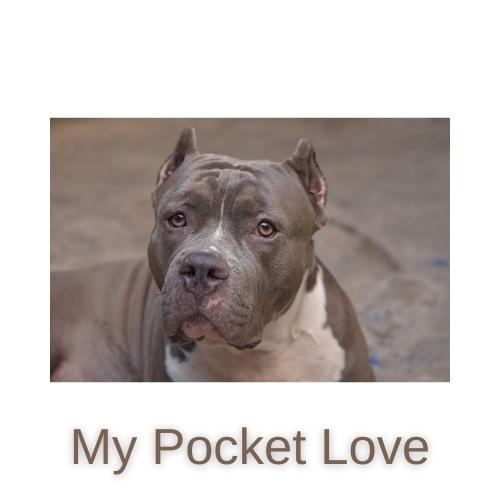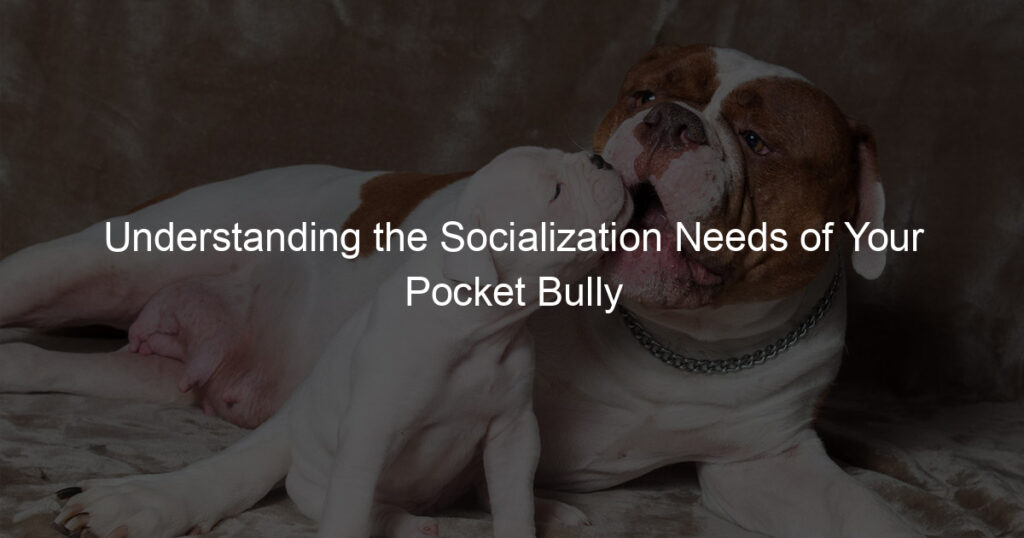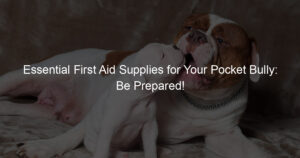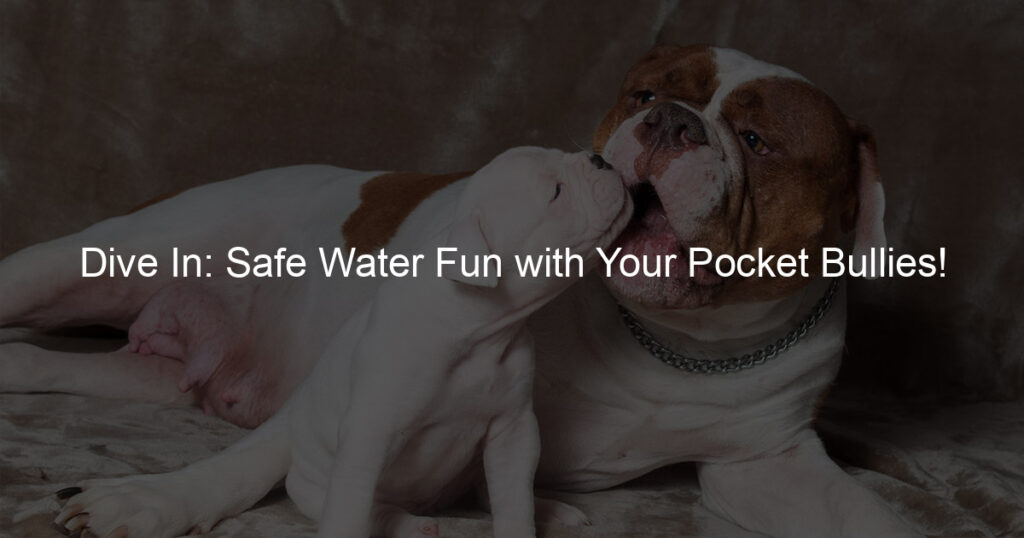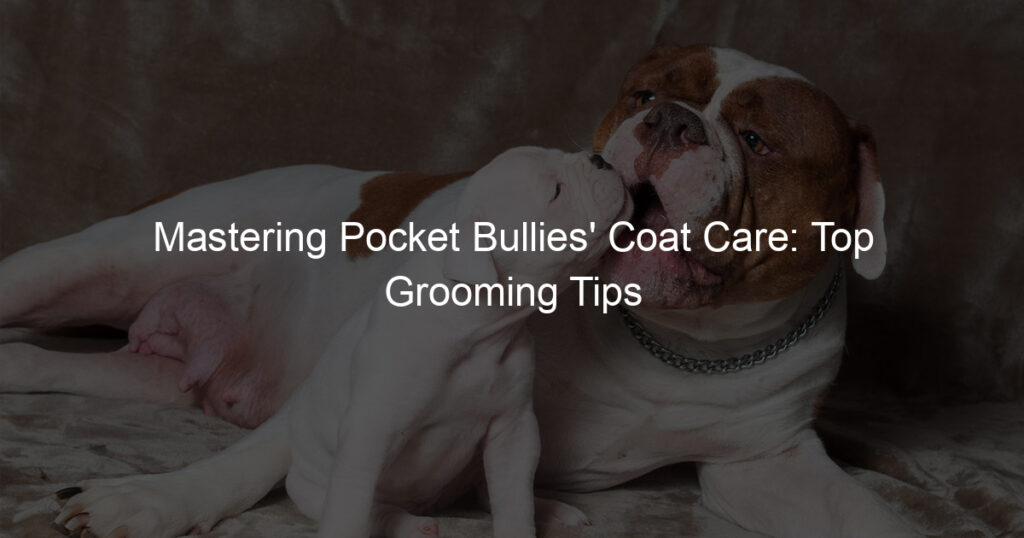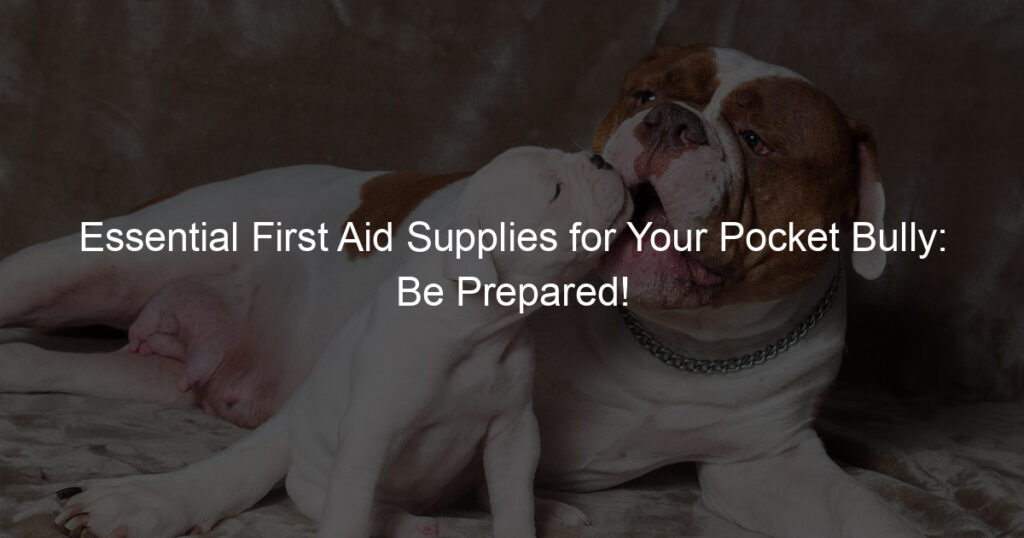
Introduction to Pocket Bullies
Welcome to our comprehensive guide on Pocket Bullies. In this section, we will introduce you to what Pocket Bullies are and their unique characteristics. So, let’s dive in!
- What are Pocket Bullies?
- Characteristics of Pocket Bullies
A Pocket Bully is a type of American Bully. They are called ‘Pocket’ because they are a compact, smaller version of the same breed. Despite their intimidating name, Pocket Bullies are known for their friendly and gentle nature. They are a popular choice for families and dog lovers due to their loyalty and affectionate behavior.
Pocket Bullies are distinct for their muscular build and short stature. They stand between 12 to 16 inches tall and weigh between 30 to 60 pounds. They have a broad chest, a thick neck, and a large, square head. Their coat is short, glossy, and can come in a variety of colors.
But it’s not just their physical traits that make them unique. Pocket Bullies are also known for their great temperament. They are friendly, patient, and rarely aggressive. They love being around people and are great with children. They are intelligent dogs that are eager to please their owners, making them relatively easy to train.
In the following sections, we will delve deeper into the socialization needs and training of Pocket Bullies. We will also share some successful case studies of socialized Pocket Bullies. Stay tuned!
Understanding Pocket Bullies Socialization
Just like humans, Pocket Bullies also need to socialize. Socialization is a crucial part of their growth and development. It helps them learn how to interact with other dogs, humans, and their environment. Let’s delve deeper into understanding the importance of socialization for Pocket Bullies and what happens when they lack it.
- Importance of Socialization for Pocket Bullies
- Effects of Lack of Socialization on Pocket Bullies Behavior
Socialization is a critical aspect of a Pocket Bully’s life. It’s during this process that they learn about their surroundings, how to interact with other animals and humans, and how to behave in different situations. This learning process starts from a young age and continues throughout their life.
When a Pocket Bully is properly socialized, they become more confident and less anxious in new situations. They learn to understand and interpret the behavior of others, which helps them react appropriately. This can prevent potential conflicts and misunderstandings with other animals or humans.
Moreover, socialization can also help Pocket Bullies to be more adaptable. They become more comfortable with changes in their environment, such as new people or animals, different sounds, and unfamiliar places. This adaptability can make them happier and healthier pets.
On the other hand, a lack of socialization can have negative effects on a Pocket Bully’s behavior. Without proper socialization, they may become fearful or aggressive in new or unfamiliar situations. This fear or aggression can lead to behavioral problems, such as excessive barking, chewing, or even biting.
Furthermore, unsocialized Pocket Bullies may have difficulty coping with changes in their environment. They may become anxious or stressed when faced with new people, animals, or situations. This stress can negatively impact their health and well-being.
Therefore, it’s essential to ensure that your Pocket Bully is properly socialized from a young age. This will help them become well-rounded, confident, and adaptable pets who can handle different situations with ease.
Socialization Needs of Pocket Bullies
Understanding the socialization needs of Pocket Bullies is crucial for their development and well-being. These dogs, like all breeds, require exposure to a variety of environments and stimuli to become well-rounded, confident adults.
Early Socialization
Early socialization is a key aspect of raising a well-behaved and confident Pocket Bully. This process should start as soon as your puppy is comfortable in their new home.
- Introducing Pocket Bullies to Different Environments
- Exposing Pocket Bullies to Various Sounds, Sights, and Smells
Introducing your Pocket Bully to different environments is a great way to help them become comfortable in various situations. This could include taking them to parks, pet stores, and on car rides. It’s important to ensure these experiences are positive, so always bring along treats and toys to make it fun for your pup.
Exposure to a variety of sounds, sights, and smells is also crucial in early socialization. This could include the sound of traffic, the sight of other animals, and the smell of different foods. This exposure will help your Pocket Bully become accustomed to the world around them and reduce the likelihood of fear or anxiety in new situations.
Remember, early socialization is not a one-time event, but a continuous process. The more positive experiences your Pocket Bully has in their early months, the more likely they are to grow into a confident and well-adjusted adult.
Human Interaction
One of the most important aspects of socializing Pocket Bullies is teaching them how to interact with humans. This includes both adults and children. Let’s delve into the specifics of this process.
- Teaching Pocket Bullies to interact with adults
Adults are typically the primary caregivers for Pocket Bullies, so it’s crucial that these dogs learn to interact with them appropriately. This involves teaching them to respect personal space, respond to commands, and behave politely.
Start by introducing your Pocket Bully to a variety of adults in different settings. This could include friends, family members, and even strangers during walks or visits to the park. Always supervise these interactions to ensure they remain positive and safe.
Use positive reinforcement to reward good behavior. For example, if your Pocket Bully remains calm and friendly during an interaction with an adult, reward them with a treat or praise. This will help them associate positive behavior with rewards, encouraging them to repeat this behavior in the future.
- Training Pocket Bullies to behave around children
Children often have a different energy level and approach to interacting with dogs, which can be overwhelming for Pocket Bullies. Therefore, it’s important to teach your dog how to behave around children.
Begin by introducing your Pocket Bully to children in a controlled environment. Make sure the child knows how to behave around dogs – no pulling on ears or tails, no yelling or running around the dog. Supervise these interactions closely.
Again, use positive reinforcement to reward good behavior. If your Pocket Bully remains calm and gentle around a child, give them a treat or praise. Over time, this will help them understand that behaving well around children leads to positive outcomes.
Remember, every dog is unique and will learn at their own pace. Be patient and consistent with your training, and over time, your Pocket Bully will learn to interact appropriately with both adults and children.
Animal Interaction
One of the key aspects of raising a well-rounded Pocket Bully is ensuring they have positive interactions with other animals. This includes both other dogs and a variety of different animals. Let’s delve into these two important areas of animal interaction.
- Socializing Pocket Bullies with other dogs
It’s crucial for Pocket Bullies to learn how to interact appropriately with other dogs. This helps them develop social skills and prevents aggressive behavior. Start by introducing your Pocket Bully to calm and friendly dogs. Always supervise these interactions to ensure they remain positive.
Remember, every dog is unique. Some may be more outgoing, while others may be more reserved. It’s important to respect the individual personality of your Pocket Bully and not force interactions. Gradual exposure to other dogs will help your Pocket Bully become more comfortable and confident.
- Introducing Pocket Bullies to other animals
Aside from other dogs, Pocket Bullies should also be introduced to a variety of other animals. This could include cats, rabbits, or even horses. The goal here is to teach your Pocket Bully that other animals are not threats, but potential friends.
When introducing your Pocket Bully to other animals, always ensure safety for all involved. Keep your Pocket Bully on a leash and allow them to observe the other animal from a distance. Gradually decrease the distance as your Pocket Bully becomes more comfortable. Remember to reward calm behavior with treats and praise.
By taking the time to properly socialize your Pocket Bully with other dogs and animals, you’re setting them up for a lifetime of positive animal interactions. This not only benefits your Pocket Bully, but also contributes to a more harmonious community.
| Key Takeaways |
|---|
| Introduce your Pocket Bully to calm and friendly dogs to start with. |
| Respect the individual personality of your Pocket Bully and do not force interactions. |
| Introduce your Pocket Bully to a variety of other animals, ensuring safety for all involved. |
| Reward calm behavior with treats and praise. |
Training Pocket Bullies
Training Pocket Bullies is not as daunting as it may seem. These dogs are known for their intelligence and eagerness to please, which makes them highly trainable. However, it’s essential to approach their training with the right strategies to ensure success. Let’s explore some effective training tips.
Pocket Bullies Training Tips
Here are some key tips to keep in mind when training your Pocket Bullies:
- Using Positive Reinforcement
- Consistency in Training
- Patience and Understanding
Positive reinforcement is a powerful training tool. This method involves rewarding your dog for good behavior, which encourages them to repeat it. Rewards can include treats, praise, or a favorite toy. For example, if your Pocket Bully sits on command, immediately reward them. This will help them associate the command with the positive outcome.
Consistency is key in any training regimen. This means maintaining the same commands, rewards, and consequences over time. If you change the rules frequently, your Pocket Bully may become confused and less likely to follow commands. For instance, if you’re training your dog not to jump on people, everyone in the household must enforce this rule consistently.
Training takes time, and it’s important to be patient with your Pocket Bully. Remember, they’re learning a new skill, and it’s natural for them to make mistakes along the way. Instead of getting frustrated, try to understand their perspective and give them the time they need to learn. Patience and understanding will go a long way in building a strong bond with your Pocket Bully and making the training process more enjoyable for both of you.
Remember, every dog is unique and may respond differently to various training methods. It’s essential to find what works best for your Pocket Bully and stick with it. Happy training!
Case Studies: Successful Socialization of Pocket Bullies
Let’s take a look at some real-life examples of successful socialization of Pocket Bullies. These case studies will help us understand how Pocket Bullies can adapt to different environments and coexist peacefully with other pets and family members.
- Case Study 1: Pocket Bully in a multi-dog household
- Case Study 2: Pocket Bully in a family with young children
Meet Max, a charming Pocket Bully who lives in a household with two other dogs – a Golden Retriever and a Pomeranian. Initially, Max was a bit aggressive and tried to assert dominance. However, with consistent training and socialization exercises, Max learned to respect the other dogs’ space and boundaries.
His owners used positive reinforcement methods, rewarding Max for good behavior. They also ensured that all dogs had their separate feeding and sleeping areas to avoid conflicts. Over time, Max became more comfortable and started engaging in playful activities with the other dogs. This case study shows that with patience and proper training, Pocket Bullies can coexist peacefully in a multi-dog household.
Next, we have Bella, a Pocket Bully who lives in a family with two young children. Initially, Bella was a bit wary of the children and would often retreat to her safe space. However, the family worked on socializing Bella with the children under supervised settings.
They taught their children how to approach Bella, pet her, and play with her. They also trained Bella to be gentle with the kids. Over time, Bella became more comfortable around the children and even protective of them. This case study demonstrates that Pocket Bullies can be great family pets, even in households with young children, with proper socialization and training.
In conclusion, these case studies highlight the importance of proper socialization and training for Pocket Bullies. With patience, consistency, and positive reinforcement, Pocket Bullies can adapt to various environments and become loving and loyal companions.
Conclusion: The Social Needs of Pocket Bullies
In this article, we have explored the social needs of Pocket Bullies, a unique breed of dogs that require special attention and care. As we have seen, socialization is crucial for their overall well-being and happiness. Let’s summarize our findings and highlight key takeaways for Pocket Bullies owners.
- Summary of the socialization needs of Pocket Bullies
- Key takeaways for Pocket Bullies owners
Pocket Bullies, like all dogs, are social creatures. They thrive in environments where they can interact with other dogs and humans. Regular socialization helps them develop a balanced temperament and reduces the risk of aggressive behavior. It’s important to start socializing them from a young age, introducing them to a variety of people, animals, and environments. This helps them become well-adjusted adults.
As a Pocket Bullies owner, remember that your pet’s social needs are just as important as their physical needs. Regular playdates, walks in the park, and training sessions can greatly contribute to their social development. Be patient and consistent in your efforts, and remember to always reward good behavior. Lastly, remember that every Pocket Bullies is unique. What works for one may not work for another. Therefore, it’s important to understand your pet’s individual needs and adjust your socialization strategies accordingly.
In conclusion, owning a Pocket Bullies is a rewarding experience. However, it comes with the responsibility of ensuring their social needs are met. By understanding and addressing these needs, you can help your Pocket Bullies lead a happy and healthy life.
